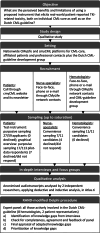Benefits and Limitations of Real-World Patient-Reported Toxicity Symptom Monitoring for Guidelines and Care, as Perceived by Patients, Clinicians, and Guideline Developers
- PMID: 40243347
- PMCID: PMC12004399
- DOI: 10.1002/cam4.70880
Benefits and Limitations of Real-World Patient-Reported Toxicity Symptom Monitoring for Guidelines and Care, as Perceived by Patients, Clinicians, and Guideline Developers
Abstract
Background: Toxicity monitoring should be modernized to include real-world patient-reported data. However, little is known about how stakeholders view the incorporation of real-world patient-reported toxicity symptoms into guidelines. This gap hinders the development of a sustained learning healthcare environment and limits the incorporation of this data into daily care.
Methods: This qualitative study, reported according to COREQ, involved interviews with 29 plus 10 chronic myeloid leukemia (CML) patients and 18 CML clinicians, including eight hematologists/guideline developers. The interviews were audio-recorded, transcribed, and independently coded in Atlas.ti. A framework, adapted from systematically sourced literature, was used for coding. Codes were assessed as either beneficial or limiting. An expert panel of all CML guideline developers completed and prioritized the identified knowledge gaps through a RAND-modified Delphi procedure.
Results: Thirty-one benefits and limitations of systematically monitoring patient-reported toxicity symptoms in the real world were identified. Compared to an existing framework, novel benefits centered around the use of aggregated data: Participants viewed real-world patient-reported toxicity symptoms as a way to systematically include patients' toxicity symptoms in the guidelines; personalize guideline advice; and fill knowledge gaps. The expert panel agreed on 14 knowledge gaps in chronic myeloid leukemia care that could be addressed through such data. Novel limitations focused on the suitability, acceptance, and applicability of toxicity symptom monitoring in routine clinical practice. Participants felt that this monitoring does not establish a causal link between medication and symptoms, and it has no added value over open conversation.
Conclusions: The benefits and limitations of adopting patient-reported real-world toxicity symptom monitoring need to be leveraged and addressed to ensure maximum value and uptake. Guideline developers viewed aggregated data as beneficial. The identified knowledge gaps provide concrete points of action for CML guideline development.
Keywords: chronic myeloid leukemia; evidence ecosystem; learning healthcare environment; patient‐reported outcome measures; real‐world evidence; toxicity monitoring.
© 2025 The Author(s). Cancer Medicine published by John Wiley & Sons Ltd.
Conflict of interest statement
Y.S., J.J.W.M.J., E.F.M.P., A.D., R.P.M.G.H., and N.M.A.B. declare institutional research support from AbbVie, AstraZeneca, and Janssen. L.V. and A.C. have no conflicts of interest to declare. J.J.W.M.J. has received institutional research support from Novartis and BMS; honoraria to the institute from Pfizer, Novartis, and Incyte; and is the founder of Apps for Care and Science Foundation and developer of the HematologyApp. The Apps for Care and Science Foundation nonprofit organization is supported by AbbVie, AstraZeneca, Amgen, Sanofi‐Genzyme, Takeda, Jazz, Roche, Servier, BMS/Celgene, Daiichi‐Sankyo, Janssen, and Incyte. A.D. has received institutional research funding from IQVIA, speaker honoraria from Janssen and Medtronic, and is founder, shareholder, and employee of Medical Data Works B.V.
Figures
Similar articles
-
The future of Cochrane Neonatal.Early Hum Dev. 2020 Nov;150:105191. doi: 10.1016/j.earlhumdev.2020.105191. Epub 2020 Sep 12. Early Hum Dev. 2020. PMID: 33036834
-
Barriers to physician adherence to evidence-based monitoring guidelines in chronic myelogenous leukemia.J Oncol Pract. 2015 May;11(3):e398-404. doi: 10.1200/JOP.2014.001099. Epub 2015 Mar 10. J Oncol Pract. 2015. PMID: 25758446
-
Lack of congruence between patients' and health professionals' perspectives of adherence to imatinib therapy in treatment of chronic myeloid leukemia: A qualitative study.Palliat Support Care. 2015 Apr;13(2):255-63. doi: 10.1017/S1478951513001260. Epub 2014 Feb 13. Palliat Support Care. 2015. PMID: 24524212
-
Targeted chronic myeloid leukemia therapy: seeking a cure.J Manag Care Pharm. 2007 Oct;13(8 Suppl A):8-12. doi: 10.18553/jmcp.2007.13.s8-a.8. J Manag Care Pharm. 2007. PMID: 17970609 Free PMC article. Review.
-
The Case for Real-world Evidence in the Future of Clinical Research on Chronic Myeloid Leukemia.Clin Ther. 2019 Feb;41(2):336-349. doi: 10.1016/j.clinthera.2018.12.013. Epub 2019 Jan 30. Clin Ther. 2019. PMID: 30709609 Review.
References
-
- Lai‐Kwon J., Cohen J. E., Lisy K., et al., “The Feasibility, Acceptability, and Effectiveness of Electronic Patient‐Reported Outcome Symptom Monitoring for Immune Checkpoint Inhibitor Toxicities: A Systematic Review,” JCO Clinical Cancer Informatics 7 (2023): e2200185, 10.1200/CCI.22.00185. - DOI - PubMed
-
- Di Maio M., Basch E., Denis F., et al., “The Role of Patient‐Reported Outcome Measures in the Continuum of Cancer Clinical Care: ESMO Clinical Practice Guideline,” Annals of Oncology 33, no. 9 (2022): 878–892. - PubMed
MeSH terms
Substances
Grants and funding
LinkOut - more resources
Full Text Sources
Medical
Miscellaneous



